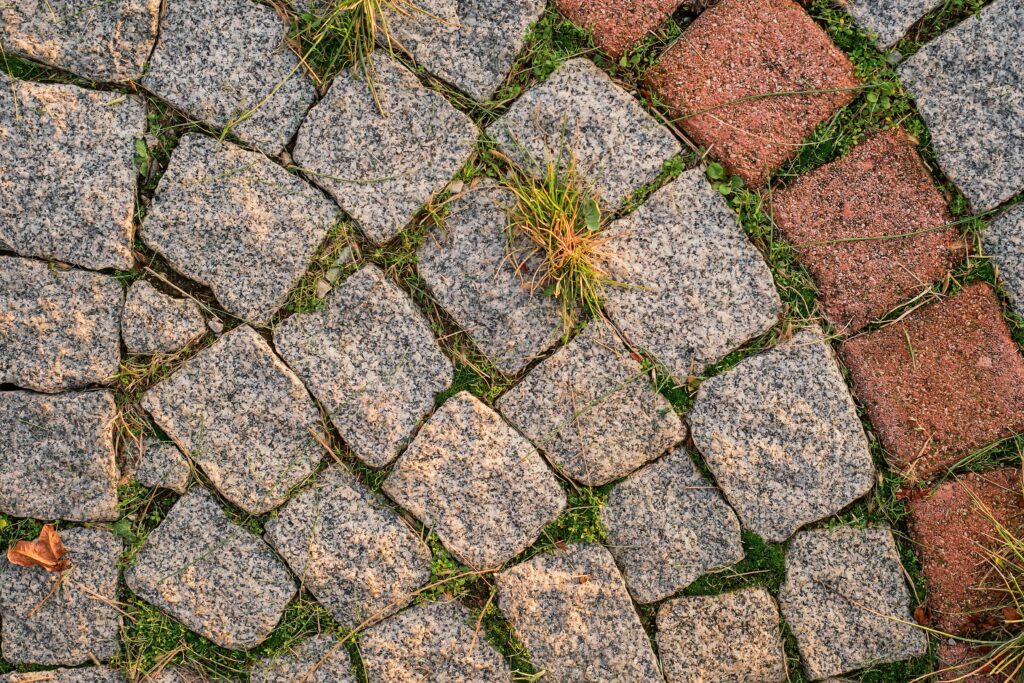In our years of business, we’ve heard a lot of misconceptions about paver patios. The internet is a valuable tool that contains a wealth of information. However, we’ve also found that not all of the information is accurate or shows the complete picture. When looking at paver patios, it seems that information can be skewed against them. We’ve seen firsthand that they are an excellent option for many people looking to spruce up their landscaping or outdoor living space. We’d like to bring a lot of the info together so that you can make your own choice.
Pro: Pavers are Durable and Long-Lasting
Most commonly, the term “pavers” refers to stones made from concrete. Some pavers are made from clay brick or natural stone. They are generally small pieces of various sizes that get installed in various colors, textures, and patterns. When installed properly, the pieces interlock to create a flexible and strong pavement system. Because there are many joints in an interlocking concrete pavement, the pavers themselves are very strong and not prone to cracking or breaking. Most pavers are 3 to 4 times stronger than even the concrete foundation of the home. Many of the manufacturers of these paving stones offer a lifetime warranty on them.
Most pavers are also manufactured with pigments and aggregates that go throughout their thickness, so if there is ever a small chip, it won’t be as noticeable. Poured concrete can also have color added to it, but that color tends to fade quickly and will probably need to be reapplied every year or two. Both pavements can benefit from a protective sealer being applied.

Pro: Paver Patios are Better for Varying Climates and Seasonal Changes
It’s important to remember that winter weather can affect your patio. In the winter months, when the moisture in the ground freezes and thaws, the ground expands and contracts. In Connecticut and Massachusetts, this can happen 90 to 100 times per year. In warmer climates, there may be fewer than 10 cycles in a year. Regardless, as the ground expands and contracts, it moves the patio too. This can easily lead to cracks in the weaker spots in solid surfaces, such as concrete. With a paver patio and how it is installed (piece by piece and fit together), there are more seams across the pavement surface, allowing the pavers to individually flex each cycle, but then ideally, settle back into the original position when the expansion recedes. A professionally installed paver patio can have minimal movement if proper construction practices are used.
Pro: Paver Patios are Low Maintenance
Repairs on or under a paver patio are seamless and much easier to perform than those around a concrete patio, where you might end up replacing the entire concrete slab. Upkeep of paver patios is very minimal. Sweep or blow any debris off the patio surface as needed. Most stains that happen can be cleaned easily with soap and water. If needed, there are several cleaners available that are formulated for the type of stain – food, oil, grease, or rust.
Protective sealers can also be applied to make maintenance and cleaning even easier. Sealers also protect the pavers from environmental wear and tear. Depending on which sealer is used, some may need to be reapplied occasionally. They come in various finishes from completely invisible to a wet look film-forming sealant.
Con: Paver Patios Take Longer to Install than Concrete Patios
Because of the process, an average-sized paver patio typically takes an experienced crew 3-5 days to install from start to finish. Concrete patios can be poured in a matter of hours, but they take 1 to 3 days to cure. Once a paver patio is installed, you can walk on it immediately.
The process to install paver patios is more in-depth than other types of patios. In most cases, small equipment will make the process easier and less back-breaking. Here’s a rundown on how to do it:
- Remove the dirt/grass from the installation area: It’s important to install the patio on a level surface, so either you or an experienced landscape company digs down to the proper depth (in Connecticut, that would be 12-18” depending on the soil type).
- Level the subsoil in the area: Level the newly exposed dirt. It’s always a good idea to compact the subsoil to prevent settling later. For extra strength, a geotextile stabilization fabric can be used to line the dugout area.
- Pour the gravel and level the area: Use a steel hand tamper or vibrating compactor to level the area after adding the gravel (in lifts of no more than four inches at a time) to the full patio area. Some areas may need to have a deeper base depending on soil type and use of the pavement – in Connecticut, for instance, we need about 8” of compacted gravel (that’s 12” compacted down to 8”) for a patio base in average soils.
- Install bedding sand: Lay down an even 1” of sand to set the pavers on. This sand works with the pavers to give the pavers some interlock from being compacted into the setting bed.
- Install the pavers: Using the design that you’ve mapped out, begin putting the pavers into place by using the click and drop method to set them into place as needed.
- Lay out and hold the edging in place: Use PVC or metal edging along the border of the patio area, and hold the edging in place by using spikes at least every 12”.
- Fill in the joints: Use a broom to push sand into the gaps between the pavers across the whole patio surface. Polymer Sand is a great sand to use in the paver joints; make sure to read the installation instructions before using it. It should be vibrated into the joints to make sure the sand gets all the way to the bottom of the paver.
- Clean and seal the patio: After you’ve installed the patio, protect your patio by making it more weather-resistant by spraying the area with a sealer formulated for pavers.
Con: Paver Patios Can Be More Expensive Than Other Options
The initial cost of a paver installation may be higher than other options, but you’ll save money in the long run with easier and less costly maintenance practices. For instance, a basic paver installation is initially 30% higher than the same-sized stamped concrete patio. However, the ongoing maintenance of stamped concrete (recoloring and sealing every 2-4 years) will eventually cost more than the paver patio.
Another cost factor is the building materials and equipment needed to install a paver patio compared to another concrete product that may or may not need them. These materials can include things such as gravel base, stabilization fabric, bedding sand, edging and spikes, compactors, and excavators. These are all in addition to the actual paving stones, which can make the initial investment higher for a paver patio.
Con: Paver Patios Grow Weeds Over Time
Paver patios are built from individual small pieces. They have a lot of joints that are filled with sand when first installed. Over time, the sand can wash out and needs to be replenished and maintained. If the joints are not topped off with sand, other debris and weed seeds will work their way in instead. Over time, the weeds can take over the pavers.
About 10 years ago, a product became available that has revolutionized the paver industry – polymer sand. When it’s installed properly, poly sand hardens in the paver joints and doesn’t allow the weeds to take root. It’s not completely fail-proof, but it prevents about 95-98% them.
It is possible to completely renovate a weedy paver patio. The joints can be cleaned out, and new poly sand can then be installed. There are professional services available to clean and restore older paver installations.

Conclusion
There isn’t one right answer for you on whether or not a paver patio is right for your needs. But, as you can see from the many pros above, it is an excellent option for many homeowners, especially those living in Connecticut and Massachusetts. Before making any decisions, make sure you talk to an expert, such as a Bahler Brothers team member, and do your research to find what type of patio will fit your design and durability needs.




